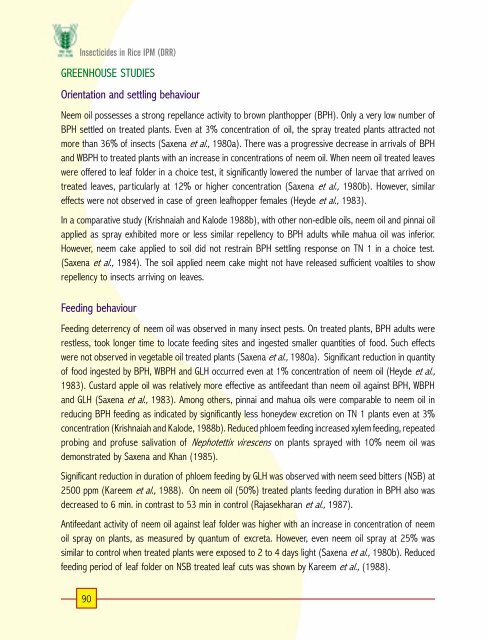priciples of insecticide use in rice ipm
priciples of insecticide use in rice ipm
priciples of insecticide use in rice ipm
Create successful ePaper yourself
Turn your PDF publications into a flip-book with our unique Google optimized e-Paper software.
Insecticides <strong>in</strong> Rice IPM (DRR)<br />
GREENHOUSE STUDIES<br />
Orientation and settl<strong>in</strong>g behaviour<br />
Neem oil possesses a strong repellance activity to brown planthopper (BPH). Only a very low number <strong>of</strong><br />
BPH settled on treated plants. Even at 3% concentration <strong>of</strong> oil, the spray treated plants attracted not<br />
more than 36% <strong>of</strong> <strong>in</strong>sects (Saxena et al., 1980a). There was a progressive decrease <strong>in</strong> arrivals <strong>of</strong> BPH<br />
and WBPH to treated plants with an <strong>in</strong>crease <strong>in</strong> concentrations <strong>of</strong> neem oil. When neem oil treated leaves<br />
were <strong>of</strong>fered to leaf folder <strong>in</strong> a choice test, it significantly lowered the number <strong>of</strong> larvae that arrived on<br />
treated leaves, particularly at 12% or higher concentration (Saxena et al., 1980b). However, similar<br />
effects were not observed <strong>in</strong> case <strong>of</strong> green leafhopper females (Heyde et al., 1983).<br />
In a comparative study (Krishnaiah and Kalode 1988b), with other non-edible oils, neem oil and p<strong>in</strong>nai oil<br />
applied as spray exhibited more or less similar repellency to BPH adults while mahua oil was <strong>in</strong>ferior.<br />
However, neem cake applied to soil did not restra<strong>in</strong> BPH settl<strong>in</strong>g response on TN 1 <strong>in</strong> a choice test.<br />
(Saxena et al., 1984). The soil applied neem cake might not have released sufficient voaltiles to show<br />
repellency to <strong>in</strong>sects arriv<strong>in</strong>g on leaves.<br />
Feed<strong>in</strong>g behaviour<br />
Feed<strong>in</strong>g deterrency <strong>of</strong> neem oil was observed <strong>in</strong> many <strong>in</strong>sect pests. On treated plants, BPH adults were<br />
restless, took longer time to locate feed<strong>in</strong>g sites and <strong>in</strong>gested smaller quantities <strong>of</strong> food. Such effects<br />
were not observed <strong>in</strong> vegetable oil treated plants (Saxena et al., 1980a). Significant reduction <strong>in</strong> quantity<br />
<strong>of</strong> food <strong>in</strong>gested by BPH, WBPH and GLH occurred even at 1% concentration <strong>of</strong> neem oil (Heyde et al.,<br />
1983). Custard apple oil was relatively more effective as antifeedant than neem oil aga<strong>in</strong>st BPH, WBPH<br />
and GLH (Saxena et al., 1983). Among others, p<strong>in</strong>nai and mahua oils were comparable to neem oil <strong>in</strong><br />
reduc<strong>in</strong>g BPH feed<strong>in</strong>g as <strong>in</strong>dicated by significantly less honeydew excretion on TN 1 plants even at 3%<br />
concentration (Krishnaiah and Kalode, 1988b). Reduced phloem feed<strong>in</strong>g <strong>in</strong>creased xylem feed<strong>in</strong>g, repeated<br />
prob<strong>in</strong>g and pr<strong>of</strong><strong>use</strong> salivation <strong>of</strong> Nephotettix virescens on plants sprayed with 10% neem oil was<br />
demonstrated by Saxena and Khan (1985).<br />
Significant reduction <strong>in</strong> duration <strong>of</strong> phloem feed<strong>in</strong>g by GLH was observed with neem seed bitters (NSB) at<br />
2500 ppm (Kareem et al., 1988). On neem oil (50%) treated plants feed<strong>in</strong>g duration <strong>in</strong> BPH also was<br />
decreased to 6 m<strong>in</strong>. <strong>in</strong> contrast to 53 m<strong>in</strong> <strong>in</strong> control (Rajasekharan et al., 1987).<br />
Antifeedant activity <strong>of</strong> neem oil aga<strong>in</strong>st leaf folder was higher with an <strong>in</strong>crease <strong>in</strong> concentration <strong>of</strong> neem<br />
oil spray on plants, as measured by quantum <strong>of</strong> excreta. However, even neem oil spray at 25% was<br />
similar to control when treated plants were exposed to 2 to 4 days light (Saxena et al., 1980b). Reduced<br />
feed<strong>in</strong>g period <strong>of</strong> leaf folder on NSB treated leaf cuts was shown by Kareem et al., (1988).<br />
90











